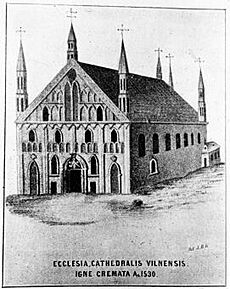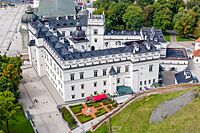List of Lithuanian monarchs facts for kids
The monarchy of Lithuania refers to the time when Lithuania was led by kings or grand dukes. This system was set up as an absolute (meaning the ruler had all the power) and hereditary monarchy (power passed down in the family).
Over the years, three main families ruled Lithuania: the House of Mindaugas, the House of Gediminas, and the House of Jagiellon. Interestingly, only one ruler, King Mindaugas I, was officially crowned as a king. Other important leaders, like Vytautas the Great and Mindaugas II, were recognized as kings by other countries, even if they weren't formally crowned.
Some rulers, like Gediminas, were even called "king" by powerful figures like Pope John XXII, though they never officially claimed the title. The idea of a hereditary monarchy first began in the 13th century with Mindaugas I. It was briefly brought back as a constitutional monarchy (where the ruler's power is limited by laws) in 1918, but this didn't last long.
When Lithuanian monarchs were inaugurated (officially started their rule) before 1569, a special cap called Gediminas' Cap was placed on their head by the Bishop of Vilnius in Vilnius Cathedral.
Today, Lithuania is a representative democracy, which means people vote for their leaders. It's a semi-presidential system where the people have the power, and there is no monarchy.
Quick facts for kids Monarchy of Lithuania |
|
|---|---|

|
|

King Mindaugas
|
|
| Details | |
| Style | His/Her Majesty |
| First monarch | Mindaugas I |
| Last monarch | Stanisław II August |
| Formation | 1236 |
| Abolition | 1795 |
| Residence | Mindaugas' Castle, Voruta (1253−1263) Gediminas' Castle, Vilnius (late 13th century−late 15th century) Palace of the Grand Dukes of Lithuania, Vilnius (late 15th century−1665) New Grodno Castle, Grodno (second half of the 18th century) |
| Appointer | Hereditary (1253–1574) Szlachta (1574–1795) Hereditary (1918) |
| Pretender(s) | Prince Inigo of Urach (disputed) |
Contents
Royal Titles in Lithuania
Lithuanian rulers used different titles over time. These titles showed their power and how other countries saw them.
King of Lithuania
From 1253 to 1263, the King of Lithuania had a special title. In Lithuanian: Iš Dievo malonės, Lietuvos karalius In Latin: Dei Gratia Rex Lettowiae In English: By the Grace of God, King of the Lithuania
Before Lithuania became a Christian kingdom, some leaders were already called kings. For example, the Livonian Rhymed Chronicle said Mindaugas' father was a great king. As Lithuania grew, other rulers also used "king" titles when dealing with other countries. Vytenis was sometimes called Rex Lethowinorum (King of Lithuanians). Gediminas used the Latin title Rex Lithuanorum et Multorum Ruthenorum (King of Lithuanians and many Ruthenians). Even the Teutonic Knights called Algirdas and his wife "Grand King" and "Grand Queen of Lithuania." Most historical records, except for some Slavic ones, called Lithuanian rulers "kings" until 1386.
Grand Duke of Lithuania
The official title of "Grand Duke of Lithuania" became common after the Pact of Horodło in 1413. Before that, many rulers were simply called kings. In Lithuania, a Grand Duke was a powerful ruler who didn't answer to anyone else. This made them like a king in practice.
The full title of Grand Duke of Lithuania was: In Lithuanian: Lietuvos didysis kunigaikštis In Latin: Magnus Dux Lithuaniae In English: Grand Duke of the Lithuania
After the Act of Krėva with Poland in 1385, the title changed. It became Dei Gratia Rex Poloniae Magnus Dux Lithuaniae (By the Grace of God, King of Poland and Grand Duke of Lithuania).
Supreme Duke of Lithuania
The title of Supreme Duke of Lithuania was mainly used during the rule of Vytautas the Great. He made agreements with his cousin Jogaila, which gave him real power over Lithuania. In 1398, Lithuanian nobles even declared Vytautas the Great as King of Lithuania. Later, the Holy Roman Emperor also approved his crowning. However, Vytautas died before the crown arrived.
Other rulers, like Jogaila's son Władysław III, also called themselves Supreme Duke. John I Albert tried to use this title in 1492, but the Lithuanian Council of Lords didn't accept it.
How Lithuanian Monarchs Began Their Rule

The ceremonies for Lithuanian monarchs took place in Vilnius Cathedral. During these events, Gediminas' Cap was placed on the ruler's head. A sword was also presented to them. The Bishop of Vilnius placed the cap, and the Grand Marshal of Lithuania presented the sword. Vytautas the Great's royal items included Gediminas' Cap, a sword, a ring, a flag, and a seal.
The first detailed record of a Grand Duke's inauguration is for Casimir IV Jagiellon. He was sent to Lithuania to rule for his brother, King Władysław III. But when he arrived in Vilnius on June 29, 1440, he was chosen as Grand Duke instead. This event showed that Lithuania was a separate country from Poland. Historian Edvardas Gudavičius says the Bishop of Vilnius placed Gediminas' Cap on his head.
Another recorded ceremony was for Alexander Jagiellon in 1492. Even though his father had named him Grand Duke, a formal election was held. The historian Maciej Stryjkowski wrote that after the election, lords lifted Alexander in the cathedral. He wore a "ducal cap with pearls and precious stones." The Bishop of Vilnius blessed him, and the Grand Marshal of Lithuania gave him a sword and a scepter.
Stryjkowski also described the election of Sigismund I as Grand Duke in 1509. Bishop Wojciech Tabor again placed the cap on his head. Grand Marshal Michael Glinski gave him a sword. Sigismund then received promises of loyalty from the Lithuanian lords while sitting on his throne. The cap was described as "red velvet with gold spheres set with precious stones."
The last ceremony to elevate a grand duke happened on October 18, 1529. Sigismund Augustus was made Grand Duke while his father was still alive. This event took place in the new lower castle, because the cathedral had burned down. The Bishop of Vilnius placed the cap on the young ruler's head. The Grand Marshal presented him with a sword.
After the Union of Lublin in 1569, which created the Polish–Lithuanian Commonwealth, these separate ceremonies in Vilnius Cathedral stopped. Gediminas' Cap lost its special meaning. Only the seal and flag remained as symbols of Lithuanian rulers.
Lithuanian nobles tried to keep a separate inauguration ceremony for the Grand Duke of Lithuania during the Union of Lublin talks. This was not officially included in the agreement. However, in 1576, Lithuanian nobles agreed that if Poland pressured them, they could choose their own monarch. In 1580, Bishop Merkelis Giedraitis gave Grand Duke Stephen Báthory a special sword and a pearl-decorated hat. This ceremony showed Lithuania's desire to remain sovereign, even though it went against the Union of Lublin.
List of Lithuanian Monarchs
House of Mindaugas (1236–1267)
| Name | Portrait | Birth | Marriages | Death | Claim |
|---|---|---|---|---|---|
| King Mindaugas 1236 – 1253 (as Grand Duke) 1253 – 1263 (as king) |
 |
c. 1203
Son of mythological Ringaudas |
(1) NN, sister of Morta 2 children (2) Morta 2 children |
1263 Aglona Assassinated by Treniota and Daumantas Aged about 60 |
Right of conquest
Son of mythological Ringaudas |
| Grand Duke Treniota 1263 – 1264 |
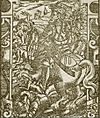 |
Unknown
Son of NN, Mindaugas' sister and Vykintas |
Unknown 1 child |
1264 Murdered by servants loyal to Mindaugas' son Vaišvilkas |
Right of conquest
Nephew of Mindaugas |
| Grand Duke Vaišvilkas Laurušas 1264 – 1267 |
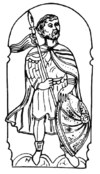 |
Unknown
Son of Mindaugas and NN, Mindaugas' firat wife |
Unmarried and childless |
1268 Was murdered by Leo I of Galicia |
Right of conquest
Son of Mindaugas |
House of Monomakh (1267–1269)
| Name | Portrait | Birth | Marriages | Death | Claim |
|---|---|---|---|---|---|
| Grand Duke Shvarn Lithuanian: Švarnas 1267 – 1269 |
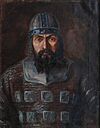 |
c. 1230 Halych Son of Daniel of Galicia |
NN, daughter of Mindaugas No children |
c. 1269 Kholm Aged about 39 |
Offered by Vaišvilkas
Brother-in-law of Vaišvilkas |
House of Mindaugas (1269–1285)
| Name | Portrait | Birth | Marriages | Death | Claim |
|---|---|---|---|---|---|
| Grand Duke Traidenis 1270 – 1282 |
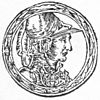 |
1220 | Ona of Masovia 1 child |
1282 Kernavė Aged 62 |
Right of conquest
Possibly a relative of Mindaugas |
| Grand Duke Daumantas 1282 – 1285 |
Unknown | Unknown | 3 March 1285 Died in a battle by Tver |
Possibly a son of Mindaugas |
House of Gediminas (1285–1440)
| Name | Portrait | Arms | Birth | Marriages | Death | Claim |
|---|---|---|---|---|---|---|
| Grand Duke Butigeidis 1285 – 1291 |
 |
None known | Unknown
Son of Skalmantas (?) |
Unknown | 1291 | Possibly a relative of Daumantas |
| Grand Duke Butvydas 1291 – 1295 |
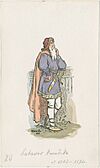 |
None known | Unknown
Son of Skalmantas (?) |
Unknown | c. 1294–1295 | Brother of Butigeidis |
| Grand Duke Vytenis 1295 – 1316 |
 |
None known | 1260
Son of Butvydas |
Vikinda 1 child |
1316 Aged 56 |
Son of Butvydas |
| Grand Duke Gediminas 1316 – 1341 |
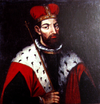 |
None known | c. 1275
Son of Butvydas |
Jaunė 13 children |
c. 1341 Raudonė Aged about 66 |
Son of Butvydas |
| Grand Duke Jaunutis 1341 – 1345 |
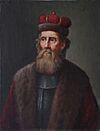 |
None known | c. 1306−1309
Son of Gediminas and Jaunė |
Unknown 3 children |
c. 1366 Aged 57−60 |
Son of Gediminas |
| Grand Duke (Diarchy with Kęstutis) Algirdas 1345 – 1377 |
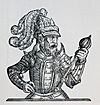 |
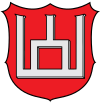 |
c. 1296
Son of Gediminas and Jaunė |
(1) Maria of Vitebsk 6 children (2) Uliana of Tver 8 children |
c. 1377 Maišiagala Aged about 81 |
Right of conquest
Son of Gediminas |
| Grand Duke (Diarchy with Kęstutis) Jogaila Algirdaitis May 1377 – August 1381 |
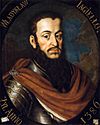 |
 |
c. 1352−1362 Vilnius Son of Algirdas and Uliana of Tver |
(1) Jadwiga of Poland No children (2) Anna of Cilli 1 child (3) Elizabeth Granowska No children (4) Sophia of Halshany 2 children |
1 June 1434 Gródek Jagielloński Aged 72−82 |
Son of Algirdas |
| Grand Duke Kęstutis 1381 – 1382 |
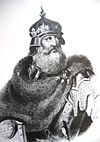 |
 |
c. 1297 Senieji Trakai Son of Gediminas and Jaunė |
Birutė 3 children |
1382 Kreva Murdered by the order of Jogaila while imprisoned Aged 84–85 |
Right of conquest
Son of Gediminas |
| Grand Duke Jogaila Algirdaitis 3 August 1382 – 1 June 1434 |
 |
 |
c. 1352−1362 Vilnius Son of Algirdas and Uliana of Tver |
(1) Jadwiga of Poland No children (2) Anna of Cilli 1 child (3) Elizabeth Granowska No children (4) Sophia of Halshany 2 children |
1 June 1434 Gródek Jagielloński Aged 72−82 |
Right of conquest
Son of Algirdas |
| Act of Kreva signed in 1385 Poland and Lithuania de jure are ruled by one monarch but remain to be separate states. |
||||||
| King of Poland and Grand Duke Jogaila Algirdaitis 3 August 1382 – 1 June 1434 |
 |
 |
c. 1352−1362 Vilnius Son of Algirdas and Uliana of Tver |
(1) Jadwiga of Poland No children (2) Anna of Cilli 1 child (3) Elizabeth Granowska No children (4) Sophia of Halshany 2 children |
1 June 1434 Gródek Jagielloński Aged 72−82 |
Son of Algirdas |
| Grand Duke Skirgaila 1386 – 1392 |
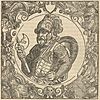 |
 |
c. 1353–1354 Vilnius Son of Algirdas and Uliana of Tver |
Unmarried and childless |
11 January 1397 Kyiv Possibly poisoned by the order of the Russian Orthodox priests Aged 42−44 |
Offered by Jogaila
Son of Algirdas Removed by Jogaila |
| Astrava Agreement signed in 1392 Following the Lithuanian Civil War, Vytautas and his successors de jure act as regents of the king of Poland until 1440. |
||||||
| Grand Duke King-elect of Lithuania Vytautas Vytautas the Great 4 August 1392 – 27 October 1430 |
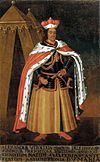 |
 |
c. 1350 Senieji Trakai Son of Kęstutis and Birutė |
(1) Anna 1 child (2) Uliana Olshanska No children |
27 October 1430 Trakai Aged about 80 |
Offered by Jogaila
Son of Kęstutis |
| Grand Duke Švitrigaila October 1430 – 1 August 1432 |
 |
 |
Before 1370 Vilnius Son of Algirdas and Uliana of Tver |
Anna of Tver 1 child |
10 February 1452 Lutsk Aged about 82 |
Son of Algirdas |
| Grand Duke Sigismund Kęstutaitis Lithuanian: Žygimantas Kęstutaitis 1432 – 1440 |
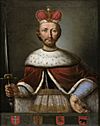 |
 |
1365 Trakai Son of Kęstutis and Birutė |
Unknown 1 child |
20 March 1440 Trakai Murdered by supporters of Švitrigaila Aged 75 |
Son of Kęstutis |
House of Jagiellon (1440–1569)
| Name | Portrait | Arms | Birth | Marriages | Death | Claim |
|---|---|---|---|---|---|---|
| King of Poland and Grand Duke Casimir IV Jagiellon Lithuanian: Kazimieras Jogailaitis 29 June 1440 – 7 June 1492 |
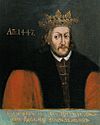 |
 |
30 November 1427 Kraków Son of Jogaila Algirdaitis and Sophia of Halshany |
Elisabeth of Austria 12 children |
7 June 1492 Old Grodno Castle Aged 64 |
Son of Jogaila |
| King of Poland and Grand Duke Alexander Jagiellon Lithuanian: Aleksandras Jogailaitis 30 July 1492 – 19 August 1506 |
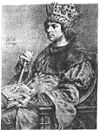 |
 |
5 August 1461 Kraków Son of Kazimieras Jogailaitis and Elisabeth of Austria |
Helena of Moscow No children |
19 August 1506 Vilnius Aged 45 |
Son of Casimir IV Jagiellon |
| King of Poland and Grand Duke Sigismund I Sigismund I the Old Lithuanian: Žygimantas Senasis 8 December 1506 – 1 April 1548 |
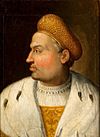 |
 |
1 January 1467 Kozienice Son of Kazimieras Jogailaitis and Elisabeth of Austria |
(1) Barbara Zápolya 2 children (2) Bona Sforza 6 children |
1 April 1548 Kraków Aged 81 |
Son of Casimir IV Jagiellon |
| King of Poland and Grand Duke Sigismund II Augustus Lithuanian: Žygimantas Augustas 1 April 1548 – 7 July 1572 |
 |
 |
1 August 1520 Kraków Son of Žygimantas the Old and Bona Sforza |
(1) Elisabeth of Austria No children (2) Barbara Radziwiłł No children (3) Catherine of Austria No children |
7 July 1572 Knyszyn Aged 51 |
Son of Sigismund I |
| Union of Lublin signed in 1569 Poland and Lithuania are united into a single Commonwealth. |
||||||
Grand Dukes of Lithuania within the Commonwealth (1569–1795)
| Name | Portrait | Arms | Birth | Marriages | Death | Claim | House |
|---|---|---|---|---|---|---|---|
| King of Poland and Grand Duke Sigismund II Augustus Lithuanian: Žygimantas Augustas 1 July 1569 – 7 July 1572 |
 |
 |
1 August 1520 Kraków Son of Žygimantas the Old and Bona Sforza |
(3) Elisabeth of Austria Barbara Radziwiłł Catherine of Austria |
7 July 1572 Knyszyn Aged 51 |
Hereditary
First monarch to introduce elective monarchy |
Jagiellon |
| King of Poland and Grand Duke Henry Lithuanian: Henrikas Valua 16 May 1573 – 12 May 1575 |
 |
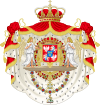 |
19 September 1551 Fontainebleau Son of Henry II and Catherine de' Medici |
(1) Louise of Lorraine, no children | 2 August 1589 Saint-Cloud Aged 37 |
Elected
Left Poland in June 1574 to succeed his brother in France Interregnum until 1575 |
Valois |
| Queen of Poland and Grand Duchess Anna Lithuanian: Ona Jogailaitė 15 December 1575 – 19 August 1587 (de facto) – 9 September 1596 (de jure) |
 |
 |
18 October 1523 Kraków Daughter of Sigismund I and Bona Sforza |
(1) Stephen Báthory, no children | 9 September 1596 Warsaw Aged 72 |
Elected co-monarch with Stephen Báthory
Sole ruler until Báthory's arrival and coronation in May 1576 Ruled after husband's death until her nephew was elected |
Jagiellon |
| King of Poland and Grand Duke Stephen Báthory Lithuanian: Steponas Batoras 1 May 1576 – 12 December 1586 |
 |
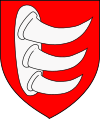 |
27 September 1533 Szilágysomlyó (Șimleu Silvaniei) Son of Stephen Báthory of Somlyó and Catherine Telegdi |
(1) Anna Jagiellon, no children | 12 December 1586 Grodno Aged 53 |
Elected as co-monarch with Anna Jagiellon
Previously Prince of Transylvania |
Báthory |
| King of Poland and Grand Duke Sigismund III Lithuanian: Zigmantas Vaza 19 August 1587 – 30 April 1632 |
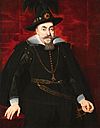 |
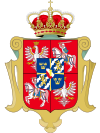 |
20 June 1566 Gripsholm Son of John III of Sweden and Catherine Jagiellon |
(1) Anne of Austria
(2) Constance of Austria |
30 April 1632 Warsaw Aged 65 |
Elected, nephew of Anna Jagiellon
Transferred capital from Kraków to Warsaw Hereditary King of Sweden until deposition in 1599 |
Vasa |
| King of Poland and Grand Duke Władysław IV also Ladislaus IV Lithuanian: Vladislovas Vaza 8 November 1632 – 20 May 1648 |
 |
 |
9 June 1595 Łobzów Son of Sigismund III and Anne of Austria |
(1) Cecilia Renata of Austria
(2) Marie Louise Gonzaga |
20 May 1648 Merkinė Aged 52 |
Elective succession
Also titular King of Sweden and elected Tsar of Russia (1610–1613) when the Polish army captured Moscow |
Vasa |
| King of Poland and Grand Duke John II Casimir Lithuanian: Jonas Kazimieras Vaza 20 November 1648 – 16 September 1668 |
 |
 |
22 March 1609 Kraków Son of Sigismund III and Constance of Austria |
(1) Marie Louise Gonzaga
(2) Claudine Françoise Mignot (morganatic marriage) |
16 December 1672 Nevers Aged 63 |
Elective succession, succeeded half-brother
Previously a cardinal Titular King of Sweden Abdicated |
Vasa |
| King of Poland and Grand Duke Michael I Lithuanian: Mykolas Kaributas Višnioveckis 19 June 1669 – 10 November 1673 |
 |
 |
31 May 1640 Biały Kamień Son of Jeremi Wiśniowiecki and Gryzelda Konstancja Zamoyska |
(1) Eleonora Maria of Austria, no children | 10 November 1673 Lwów Aged 33 |
Elected
Born into nobility of mixed heritage, the son of a military commander and governor |
Wiśniowiecki |
| King of Poland and Grand Duke John III Sobieski Lithuanian: Jonas Sobieskis 19 May 1674 – 17 June 1696 |
 |
 |
17 August 1629 Olesko Son of Jakub Sobieski and Teofila Zofia |
(1) Marie Casimire d'Arquien, 13 children | 17 June 1696 Wilanów Aged 66 |
Elected
Born into nobility A successful military commander |
Sobieski |
| King of Poland and Grand Duke Augustus II Lithuanian: Augustas II Stiprusis 15 September 1697 – 1706 (1st reign, 9 years) |
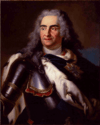 |
 |
12 May 1670 Dresden Son of John George III and Princess Anna Sophie of Denmark |
(1) Christiane Eberhardine of Brandenburg-Bayreuth, 1 son by wife | 1 February 1733 Warsaw Aged 62 |
Elected
Previously Elector and ruler of Saxony Dethroned by Stanislaus I in 1706 during the Great Northern War |
Wettin |
| King of Poland and Grand Duke Stanislaus I Lithuanian: Stanislovas I Leščinskis 12 July 1704 – 8 July 1709 (1st reign) |
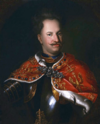 |
 |
20 October 1677 Lwów Son of Rafał Leszczyński and Anna Jabłonowska |
(1) Catherine Opalińska, 2 children | 23 February 1766 Lunéville Aged 88 |
Usurped
Nominated as ruler in 1704, crowned in 1705 and deposed predecessor in 1706 Exiled in 1709 |
Leszczyński |
| King of Poland and Grand Duke Augustus II Lithuanian: Augustas II Stiprusis 8 July 1709 – 1 February 1733 |
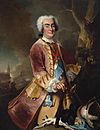 |
 |
12 May 1670 Dresden Son of John George III and Princess Anna Sophie of Denmark |
(1) Christiane Eberhardine of Brandenburg-Bayreuth, 1 son by wife | 1 February 1733 Warsaw Aged 62 |
Restored | Wettin |
| King of Poland and Grand Duke Stanislaus I Lithuanian: Stanislovas I Leščinskis 12 September 1733 – 26 January 1736 (2nd reign) |
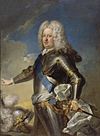 |
 |
20 October 1677 Lwów Son of Rafał Leszczyński and Anna Jabłonowska |
(1) Catherine Opalińska, 2 children | 23 February 1766 Lunéville Aged 88 |
Elected
His election sparked the War of the Polish Succession Deposed by Augustus III in 1736 |
Leszczyński |
| King of Poland and Grand Duke Augustus III Lithuanian: Augustas III Saksas 5 October 1733 – 5 October 1763 |
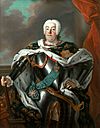 |
 |
17 October 1696 Dresden Son of Augustus II the Strong and Christiane Eberhardine |
(1) Maria Josepha of Austria, 16 children | 5 October 1763 Dresden Aged 66 |
Usurped
Proclaimed King of Poland in 1733, crowned in 1734 Dethroned elected predecessor in 1736 |
Wettin |
| King of Poland and Grand Duke Stanislaus II Augustus Lithuanian: Stanislovas Augustas II Poniatovskis 7 September 1764 – 25 November 1795 |
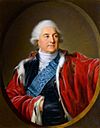 |
 |
17 January 1732 Wołczyn Son of Stanisław Poniatowski and Konstancja Czartoryska |
Unmarried | 1 February 1798 Saint Petersburg Aged 66 |
Elected
Born into nobility Last King of Poland and Grand Duke of Lithuania, his reign ended in the Partitions of Poland |
Poniatowski |
House of Urach (1918)
| Name | Portrait | Arms | Birth | Marriages | Death | Claim |
|---|---|---|---|---|---|---|
| King-elect Mindaugas II 11 July 1918 – 2 November 1918 |
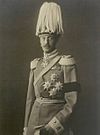 |
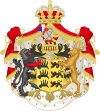 |
30 May 1864 Monaco Son of Wilhelm, 1st Duke of Urach and Princess Florestine of Monaco |
(1) Duchess Amalie in Bavaria 9 children (2) Princess Wiltrud of Bavaria No children |
24 March 1928 Rapallo Aged 63 |
De jure restoration
Offered by the Lithuanian Council Offer withdrawn |
Timeline of Lithuanian Rulers
| Comparative reigns of Lithuanian monarchs |
|---|
 |
Key Moments in Lithuanian Monarchy
The Kingdom of Lithuania Under Mindaugas I
Around the 13th century, powerful groups like the Teutonic Order and Livonian Brothers were a big threat to pagan Lithuania. To protect his land, Duke Mindaugas worked to unite Lithuania. He also decided to convert to Christianity and become a king. In 1250 or 1251, he became a Roman Catholic. In 1253, Mindaugas and his wife Morta were crowned King and Queen. This helped Lithuania gain international recognition as a Western country.
Attempts to Crown More Kings
Some historical papers suggest that in 1398, Lithuanian nobles recognized Vytautas the Great as their king. Vytautas himself tried to be officially crowned king at least three times. However, these attempts failed. At this time, the Grand Duchy of Lithuania and the Kingdom of Poland were ruled together by Jogaila. The Polish nobles strongly opposed the idea of a fully independent Lithuanian monarchy. They didn't want Poland to lose its influence.
In 1526, the Lithuanian Council of Lords suggested that Lithuania become a kingdom. But the ruling Jagiellonian family rejected this idea.
The Short-Lived Kingdom of Lithuania (1918)
During World War I, the German Empire wanted to take over Lithuania. To avoid this, the Council of Lithuania decided to create a constitutional monarchy. They invited Wilhelm von Urach to be King, with his home at Verkiai Palace. He was given conditions, like taking the name Mindaugas II. His children had to go to Lithuanian schools. He could only hire Lithuanian citizens who spoke the official language. He also couldn't leave the country for more than two months a year without permission.
As the war ended, Germany was losing. On October 5, 1918, Germany announced it supported nations' right to be independent. Soon after, France also made it clear that a German king in Lithuania was unacceptable. On November 2, 1918, the Council decided to give up the idea of a monarchy. They chose to become a fully independent republic instead.
Monarchy in Modern Times
Today, there are no monarchist political parties in Lithuania. However, there is a movement that wants to bring back the monarchy from 1918. They believe the monarchy was never truly abolished.
Stanislovas Švedarauskas, from the "Palace of the Kingdom of Lithuania" organization, said: "When Mindaugas I died in 1263, the Kingdom disappeared. But later, Gediminas called himself 'King of Lithuanians.' In 1918, the State Council left the question of Mindaugas II to the Constituent Assembly. The Assembly declared Lithuania a republic in 1920. But I've never heard that they officially canceled the 1918 declaration to create a constitutional monarchy."
Political expert Česlovas Iškauskas responded: "In 1918, Germany had a lot of power. But now, the idea of bringing back the monarchy seems like a game. Lithuania has more important issues today, like facing current threats."

Prince Inigo von Urach, the grandson of Mindaugas II, says he is the rightful heir to the Lithuanian throne. He is willing to become King if the people of Lithuania want him to. He said in an interview, "It's not my decision, it's the decision of the people here, the citizens of Lithuania. But I promise—if they want me, I would be ready for this job." He also mentioned that his grandfather wanted to keep the claim to the thrones of both Lithuania and Monaco.



